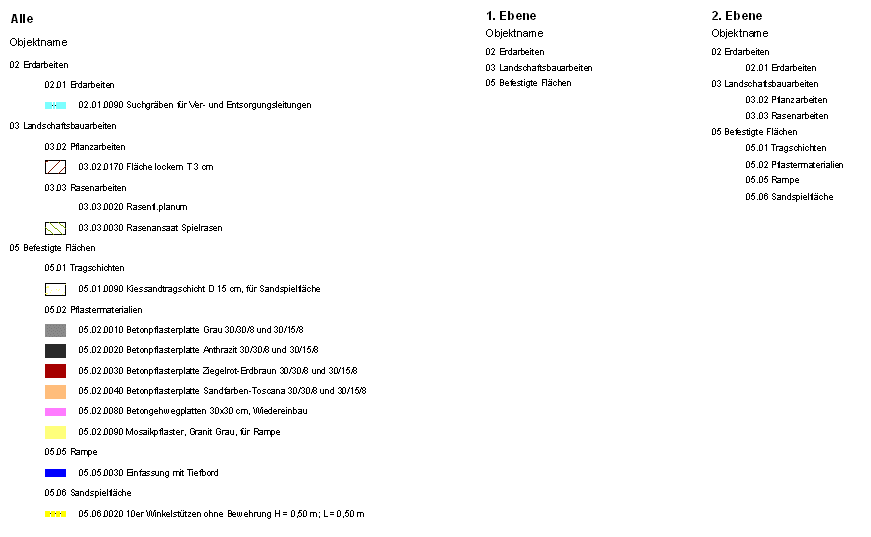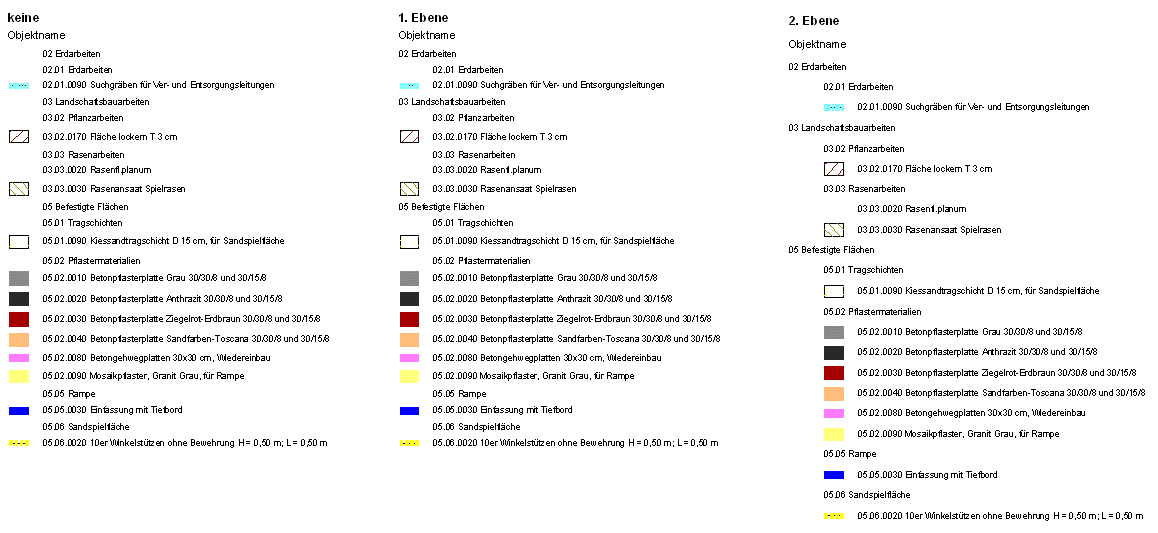Table of Contents
Create legend
Description
From the Object manager legends can be generated automatically. These legends are associative, ie changes in the Object Manager are updated automatically. The selected group in the Mass tree, because the function only relates to the subordinate groups and objects.
Features
Select the desired group in the Mass tree and then access it via the toolbar or via the context menu Tools the command:
Create legend
In dialogue Configure legend are already defaults within the configuration DATAflor Standard met. This configuration cannot be overwritten. If you would like to make adjustments, copy the basic configuration first. Further information on configuration can be found in the chapter: Configuration and information about the individual areas can be found here: Options, Groups, Values, Schedule.
For the Legend title The current group name from the object manager is automatically used. However, any entry can be made here.
The Info field can be used as a subtitle. The default setting is to display the information from the object manager.
in The Field Layer You can select an existing layer from the layer list or create a new layer and create the legend by entering a name. The default is the layer 0_Legend.
For the legend it is Table style DATAflor CAD model preset. It is optimized for use in modeling. This table style and the table style DATAflor CAD layout are created automatically if they do not already exist. Select the appropriate table style from the list.
In dialogue Table style (TABLE STYLE) you can create a new table style or an existing one Edit table style.
The predefined DATAflor Table styles is the Font Arial assigned. This supports the use of exponents (m², m³).
With the button [Column selection] You can define which columns should be displayed within the legend.

The columns are preset Object name and Area. Depending on availability, select additional columns in the group Object information out of. The user-defined ones are also displayed here Attribute (please refer Formulas & Lists) are listed if they have already been assigned to objects in the mass tree. You can find these in the group Formulas. The object manager contains one Position coupling, additional columns will appear in the group Documentation/coupling displayed.
The columns in the table are sorted using the arrow keys: up > down corresponds to left > right.
In the area Preview The legend with the current settings is displayed. Changes are continuously updated when the option Automatically update preview is activated.
Configuration
In dialogue Configure legend are already defaults within the configuration DATAflor Standard met. This configuration cannot be overwritten. If you would like to make adjustments, copy the basic configuration first.
Options
| Remove empty groups | Groups from the Object managerto which no objects have been assigned are not displayed in the legend. |
| Show individual objects | All in Object manager assigned objects are listed in the legend. If this option is deactivated, the individual objects are not displayed in the legend, but they are included in the calculation of the total. This can mean that the value of the total row does not match the total of the group. |
| Show deduction areas | In addition to the (activated) individual objects, deduction objects (surfaces only) can be added to the column Area list. Here the deduction areas show their value negative Sign on. The areas that contain deduction areas show their actual value (without deduction) on. |
| Sort alphanumerically | Regardless of the sorting order of the mass tree (alphanumeric or by acquisition), the legend can always be output alphanumeric with this option. Manual changes in the mass tree disable the use of the automatic one Sort order. To reset the mass tree sort order to the setting defined in the options, invoke the following tool: Reset manual tree sorting. |
| Show info | The text from the Info field is displayed under the title of the legend. |
| Show total line | Allows the bottom line Total hide. |
| Adjust text height automatically | The text heights of the groups and individual objects are calculated using an internal size factor so that each subordinate level is smaller than the superordinate level. If this option is deactivated, the data is inserted in the legend with a uniform text height. |
| update automatically | Quantities and graphics from the Object manager are automatically updated when changes are made. For example, when another object is detected or another graphic variant is activated. |
Groups
The field Advertising controls the display of objects depending on the selected group.
All shows all objects from the Object manager
With 1st level only the first level below the highlighted group is displayed.
The selection of 2st level indicates another level.
For example:

The field hierarchy controls the display of hierarchy objects.
With All all groups are arranged hierarchically.
No creates all objects one below the other.
1st level: One level is indented.
2st level: Two levels are indented.
For example:

About the button [Select groups] You can select the groups/subgroups that should be displayed in the legend. For this purpose, the current mass tree structure without objects is displayed in a separate dialog. If a group is deactivated, all groups below it are automatically deactivated.

Values
| Values round up | With this option, the displayed values can be rounded up to a specific place (e.g. 10s). |
| Use decimal point | Here, a decimal point is used instead of the decimal point used by CAD. |
| Show units | Allows you to view the units, which include attributes such as number, length, area, and volume. |
| Show values | All: The sums of subordinate objects and groups are formed on all levels. save: No sums are formed. not last: Totals are only displayed for groups, not for individual objects. only last: Totals are only created for the groups under which there are objects directly. Parent groups do not receive any totals. The total of all objects is created in a further line, as long as the selection is not made save is hit. |
| Values in columns | All: All values for the objects are displayed. assigned unit of measure: Only the unit of measure assigned to the object (or group/item) is displayed, regardless of the object type. Ie for an area that is in a group/position with the unit Meter has been recorded, the value for the length is then entered. The area value is hidden. Only the highest unit of measure: Only the highest unit of measure is displayed in the legend: number, length/circumference, area or volume. The displayed value depends on the object type recorded. Ie for an area that is in a group/position with the unit Meter has been recorded, the value for the area is then used. The length value is hidden. |
| Number of decimal places | Controls the display of the decimal places. The default value is 2. |
Schedule
| Show graphic | Controls the display of the graphic in the legend. |
| Graphics always in front | All graphics are left-justified one below the other in the legend. |
| not for single objects | The graphics assigned in the object manager are not listed for the individual objects. |
| Sum graph | In the same way as the object manager, the higher-level graphic is transferred to subgroups and shown in the legend. If this option is deactivated, only the graphic that was precisely assigned to the group is displayed in the legend. |
| Show frame | A frame is created around the graphic. |
| Display automatically | The size of the graphic display is calculated automatically. It is based on the text size and is therefore variable. Via the input fields Height and Width The size of the graphic display can be specified manually. |
| Scaling factor for graphics | The graphic is scaled with the entered factor. The basis for the calculation is the setting made in the Object manager assigned graphic. |
Block objects that were recorded in the mass tree on a folder with the Unit unit are displayed directly with this block graphic in the legend. This applies to both simple block objects and dynamic blocks. Dynamic blocks are represented with parametric properties in the legend: e.g. visibility and angle.
Use the command to edit the legend Edit legend.
EXCEL: Using the command TABLE EXPORT Legends can also be exported as a CSV file.






